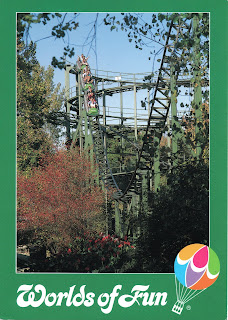Of Worlds of Fun’s three original coasters two were produced by the same manufacturer Anton Schwarzkopf of West Germany, they were the Zambezi Zinger and Schussboomer. A recent post by a visitor commented incorrectly that Zinger had been found at a park near Chicago, Six Flags Great America. In truth, the coaster there (Whizzer) is similar to Zinger, but it is not Zinger. It made me think that maybe there needed to be a post discussing the Schwarzkopf coasters and how Worlds of Fun’s two original coasters fit into the Schwarzkopf family tree.
Based in West Germany, all of Schwarzkopf’s earliest rides were intended to be portable, to move from fair to fair, disassembled and reassembled multiple times. For those familiar with Schussboomer that description should sound familiar, as Schussboomer was a Wildcat portable model, Schwarzkopf’s first coaster model that he produced. Schussboomer was bought by Mid-America Enterprises used, and since the first Wildcat model was produced in 1964 it has been hypothesized that Schussboomer might have been the prototype Wildcat. There is some evidence to support this, as though many Wildcat models were produced and many did make their way over to the United States, there are none that are (or were) exactly like Schussboomer. Schussboomer lacked the swooping turns found on other, later Wildcat models. Then, there is the fact that it was bought used, in 1972, when the very first model was only produced eight years earlier. Regardless, Schussboomer was a popular coaster at Worlds of Fun, yet was removed and scrapped only eleven years after it opened.
Many who remember Schussboomer, or any Wildcat coaster for that matter might not immediately make the connection between it and Zinger, though less than a decade separate the two technologies. The evolution was quick, in 1968 Schwarzkopf came out with his Jet Star I model, the first of his coasters to introduce the bobsled-style seating arrangement, and two years later the Jet Star II was introduced furthering the innovation with a three-seat car, and for the first time the electric spiral lift. Though technologically similar to Zinger, it should be remembered that Jet Star I and Jet Star II models were portable, "mass produced" models, like cars manufactured on an assembly line. There would be one more jump that would be needed to make Zinger possible and that was the introduction of the Speedracer model.
Tig'r at Indiana Beach a Jet Star I model. Notice the similar cars to the later models, but it has a more traditional chain lift hill.
Jet Star II at Lagoon in Salt Lake City, Ut. Notice the spiral lift and bobsled-style seating arrangement, very similar to those on Zinger.
In 1971, the first Speedracer model was introduced at Six Flags Over Texas, it was called Big Bend. Speedracers set themselves apart from the prior Jet Star II by not only being non-portable, but also less compact and offering a custom layout, designed to meet the land they were built on rather than the other way around. In 1972, Schwarzkopf would use the achievement of Big Bend to build his last of the Jet Star portable series, Jet Star III or Jumbo Jet.
In 1973, Schwarzkopf opened his second Speedracer, known as Zambezi Zinger. Zinger would follow Big Bend as the second custom, non-portable design, sometimes also referred to as an Extended Jumbo Jet. Zinger would incorporate everything learned from the entire Jet Star Series and Big Bend; the spiral electric lift, ground-hugging curves, a high-speed turn around the lift, but instead of two cars making a train, with Zinger it would be three. In 1976, the last two of Speedracer models would open, and they would be identical twins, the Willard Whizzers at the two Marriott Great America parks (Gurnee, Il., and Santa Clara, Ca.). The Whizzers though identical to each other would also be completely different in layout to the Zinger and Big Bend. The details that confuse people to think Whizzer could be Zinger is the fact that Whizzer still maintains the features of all Speedracer and Jumbo Jet coasters, the bobsled trains, the electric spiral lift and the quick, speedy turns.
It might look very familiar but this isn't Zinger. It is Whizzer at Six Flags Great America. Still, the familiar resemblance is definitely there.
In the end there would be a total of four Speedracer coasters ever built (Big Bend, Zinger, and the two Whizzers) but today only one still operates in its original location, which is the Whizzer at the now Six Flags Great America in Gurnee, Il.. In 2012, Whizzer was recognized not only for itself but for its family of Speedracer coasters as a Roller Coaster Landmark by the American Coaster Enthusiasts.
Anton Schwartzkopf perfection.
By the mid-70’s Schwarzkopf would abandon the bobsled-style cars in favor of the more traditional side-by-side seating arrangement and chain lift. His coaster, Revolution at Magic Mountain would introduce the world to the first modern looping coaster in 1976, while Schwarzkopf also continued to build portable looping coasters as well. The Six Flags chain has held on to many of Schwarzkopf’s coasters, the Whizzer at Six Flags Great America, the Revolution at Six Flags Magic Mountain, Shockwave at Six Flags over Texas, Silver Bullet at Frontier City, and my favorite, Mind Bender at Six Flags over Georgia.
Not to be confused with Zinger this is Whizzer at Six Flags Great America
Anton Schwarzkopf himself, while a mastermind at amusement park rides lacked a great deal of business sense and declared bankruptcy several times before retiring finally in 1995. Anton passed away in 2001, but thankfully many of his fabulous rides still live on.
Learn more about Schwartzkopf and his rides at Schwartzkopf-Coaster.Net







